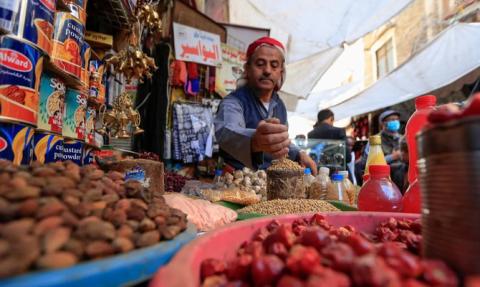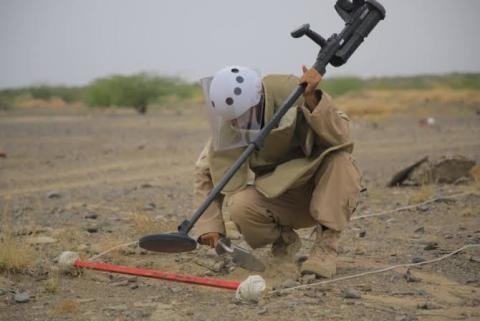In Yemen, aid work stalls along with fuel, supply imports


That month, much-awaited shipment of replenishment supplies for its water and sanitation interventions in conflict-torn Yemen is expected to arrive, bringing tanks, pumps and tools like welding machines. As with fuel, food and medicines, these supplies have become scarce — and may be more difficult to obtain in coming weeks.
A country heavily reliant on outside goods, Yemen imports 90 percent of its food supply. Not only is there insufficient arable land in the country, water is hard to access as well. Further, what little arable land is often used to sow khat, a leafy plant that serves as a stimulant when chewed, instead of food crops because there is greater demand for the former.
But in March this year, a Saudi-led coalition imposed a naval blockade and launched airstrikes on areas they believe are held by Houthi rebels as a way to prevent the Yemeni government from falling into militant forces. Since then, it has become even more difficult to import commodities and supplies — a situation that has been creating a dent on humanitarian operations in the country.
Tariq Riebl, a program coordinator for Oxfam GB in Yemen, notes that just 10 to 20 percent of shipments to the port of Hodeida, for example, actually enter the country. And that percentage is expected to drop even further, following Tuesday’s airstrikes that destroyed cranes and warehouses in Hodeida, the main entry point for aid supplies heading for northern Yemen. The humanitarian logistics cluster closed the port the following day — just for 48 hours, but Riebl fears it may be longer. At the moment, all shipments to the port are suspended.
“We don’t know if, going forward, ships would be able to come [into] Hodeida,” he told Devex from Yemen.
While there are other ports in Yemen, none of them can transport supplies to the northern part of the country. The port in Aden, while accessible, can only serve populations around the city. The secondary port of Mokha, meanwhile, was hit by an airstrike in July — which reportedly killed 65 civilians — and does not have enough capacity. The port of Mukalla, on the other hand, is under al-Qaida control and is therefore “not an option,” according to the Oxfam official.
Despite these setbacks, donors seem to have given very little attention to the crisis, which has been elevated to a Level 3 emergency, the highest level on the scale. This designation is supposed to warn the international community that the country is in desperate and urgent need of aid.
As such, the few aid organizations on the ground are resorting to various ways to continue operations. Many have begun looking to the black market for fuel, and even those that are able to bring in supplies don’t always find sufficient quantities — or even the right kind of supply. The World Food Program, for instance, was able to bring in diesel, which is useful for generators but not for transportation as most vehicles in Yemen run on gasoline.
The fact that “funding in Yemen is atrocious,” according to Riebl, doesn’t help. Of this year’s $1.6 billion humanitarian appeal for the crisis in the country, only 18 percent has been funded to date. ECHO, the EU’s humanitarian aid arm, topped up its contributions last week with an additional 10 million euros ($11 million), which according to Riebl is the “second-biggest donor allocation so far.”
But that’s a “paltry sum” for a crisis of this level, where 21 million people are in dire need of humanitarian assistance, according to Mark Kaye, Save the Children’s interim advocacy and communications director in Yemen.
Of that figure, close to 13 million are in dire need of food.
“Families are going to bed not knowing where are they going to get food for the next day,” Kaye said, adding that up to 1.5 million people are likely to fall into malnutrition by the end of this year. According to a recent assessment by the U.N.’s food aid arm, the country is a “step away” from famine.
But the scant attention the crisis in Yemen is receiving may also be due to the limited reports coming out of the country. Donor agencies, which rely on the reports from aid groups on the ground, evacuated even before the airstrikes and have not returned since, according to Riebl.
The few organizations left in Yemen have become extra cautious, relying mainly on national staff to carry out their operations. For its part, Oxfam sometimes shares information on its movements to the Saudi-led coalition as a precautionary measure against bombings. Nevertheless, one of its warehouses in the northern governorate of Saada — a stronghold of the Houthi rebels — was hit by an airstrike in April.

Yemeni officials on Monday condemned arrests and prosecutions by the Iran-backed Houthi militia directed against media, journalists and celebrities…

Yemen's warring parties are gearing up for new waves of conflict in 2023 amid a lack of decisive steps towards sustainable peace, adding to the suf…

The UAE will help to recruit doctors and deliver crucial supplies for hospitals in Yemen under a major healthcare drive. The Khalifa bin…